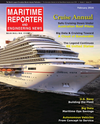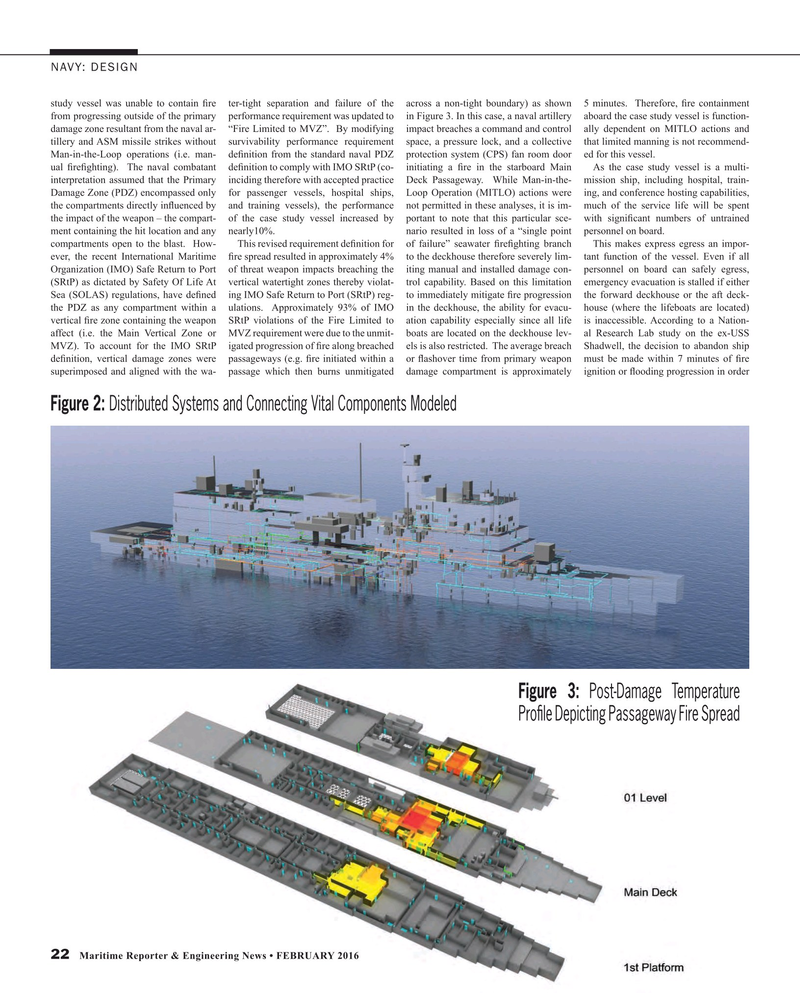
Page 22: of Maritime Reporter Magazine (February 2016)
Cruise Ship Technology Edition
Read this page in Pdf, Flash or Html5 edition of February 2016 Maritime Reporter Magazine
NAVY: DESIGN study vessel was unable to contain ? re ter-tight separation and failure of the across a non-tight boundary) as shown 5 minutes. Therefore, ? re containment from progressing outside of the primary performance requirement was updated to in Figure 3. In this case, a naval artillery aboard the case study vessel is function- damage zone resultant from the naval ar- “Fire Limited to MVZ”. By modifying impact breaches a command and control ally dependent on MITLO actions and tillery and ASM missile strikes without survivability performance requirement space, a pressure lock, and a collective that limited manning is not recommend-
Man-in-the-Loop operations (i.e. man- de? nition from the standard naval PDZ protection system (CPS) fan room door ed for this vessel.
ual ? re? ghting). The naval combatant de? nition to comply with IMO SRtP (co- initiating a ? re in the starboard Main As the case study vessel is a multi- interpretation assumed that the Primary inciding therefore with accepted practice Deck Passageway. While Man-in-the- mission ship, including hospital, train-
Damage Zone (PDZ) encompassed only for passenger vessels, hospital ships, Loop Operation (MITLO) actions were ing, and conference hosting capabilities, the compartments directly in? uenced by and training vessels), the performance not permitted in these analyses, it is im- much of the service life will be spent the impact of the weapon – the compart- of the case study vessel increased by portant to note that this particular sce- with signi? cant numbers of untrained ment containing the hit location and any nearly10%. nario resulted in loss of a “single point personnel on board. compartments open to the blast. How- This revised requirement de? nition for of failure” seawater ? re? ghting branch This makes express egress an impor- ever, the recent International Maritime ? re spread resulted in approximately 4% to the deckhouse therefore severely lim- tant function of the vessel. Even if all
Organization (IMO) Safe Return to Port of threat weapon impacts breaching the iting manual and installed damage con- personnel on board can safely egress, (SRtP) as dictated by Safety Of Life At vertical watertight zones thereby violat- trol capability. Based on this limitation emergency evacuation is stalled if either
Sea (SOLAS) regulations, have de? ned ing IMO Safe Return to Port (SRtP) reg- to immediately mitigate ? re progression the forward deckhouse or the aft deck- the PDZ as any compartment within a ulations. Approximately 93% of IMO in the deckhouse, the ability for evacu- house (where the lifeboats are located) vertical ? re zone containing the weapon SRtP violations of the Fire Limited to ation capability especially since all life is inaccessible. According to a Nation- affect (i.e. the Main Vertical Zone or MVZ requirement were due to the unmit- boats are located on the deckhouse lev- al Research Lab study on the ex-USS
MVZ). To account for the IMO SRtP igated progression of ? re along breached els is also restricted. The average breach Shadwell, the decision to abandon ship de? nition, vertical damage zones were passageways (e.g. ? re initiated within a or ? ashover time from primary weapon must be made within 7 minutes of ? re superimposed and aligned with the wa- passage which then burns unmitigated damage compartment is approximately ignition or ? ooding progression in order
Figure 2: Distributed Systems and Connecting Vital Components Modeled
Figure 3: Post-Damage Temperature
Pro? le Depicting Passageway Fire Spread 22 Maritime Reporter & Engineering News • FEBRUARY 2016
MR #2 (18-25).indd 22 2/3/2016 10:28:01 AM

 21
21

 23
23
